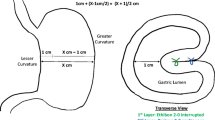Abstract
Background
Laparoscopic adjustable gastric banded plication (LAGBP) is a new restrictive bariatric procedure combining adjustable banding and greater curvature plication of the stomach. This study aimed to report the evolution of this surgical technique and analyze the surgical results.
Methods
Eighty patients who underwent LAGBP were enrolled in this study. The band-first technique was used in 50 patients from May 2009 to June 2011 and was then changed to the plication-first technique from July 2011 to October 2011. Patients' demographics and pre- and postoperative data, including complications and weight loss, were collected and analyzed.
Results
Eighty patients (26 men and 54 women) with a mean age of 30.75 ± 8.68 years and a mean body mass index of 38.05 ± 4.73 kg/m2 were evaluated with a mean follow-up of 10.52 (1–24) months. The average operation duration and hospital stay were 92.85 ± 35.86 min and 1.73 ± 1.04 days, respectively. No intraoperative complications or surgical mortality was observed in this series. Four (8 %) postoperative complications occurred with the band-first technique and one (3 %) with the plication-first technique. Mean excess weight loss (percentage) at 6, 12, 18, and 24 months were 42.59 ± 13.67, 56.38 ± 19.89, 57.59 ± 19.88, and 65.84 ± 17.36 %, respectively. The frequency of band adjustment was 2.44 ± 2.21 times in 2 years.
Conclusions
In this present 2-year result, LAGBP using plication-first technique revealed fewer complications and good weight loss. Longer follow-up is still necessary to be accepted as a stand-alone bariatric procedure.



Similar content being viewed by others
References
Barness LA, Opitz JM, Gilbert-Barness E. Obesity: genetic, molecular, and environmental aspects. Am J Med Genet A. 2007;143A:3016–34.
Caballero B (2007) The global epidemic of obesity: an overview. Epidemiology Rev, 29:1–5.
Schauer P, Ikramuddin S, Gourash W, et al. Outcomes after laparoscopic Roux-en-Y gastric bypass for morbid obesity. Ann Surg. 2000;233:515–29.
Scopinaro N, Adami GF, Marinari GM, et al. Biliopancreatic diversion. World J Surg. 1998;22:936–46.
Segaran E. Provision of nutritional support to those experiencing complications following bariatric surgery. Proc Nutr Soc. 2010;69:536–42.
Zinzindohue F, Chevallier JM, Douard R, et al. Laparoscopic gastric banding: a minimally invasive surgical treatment for morbid obesity—prospective study of 500 consecutive patients. Ann Surg. 2003;237:1–9.
Ramos A, GalvaoNeto M, Galvao M, et al. Laparoscopic greater curvature plication: initial results of an alternative restrictive bariatric procedure. Obes Surg. 2010;20:913–8.
Huang CK, Lo CH, Shabbir A, et al. Novel bariatric technology: laparoscopic adjustable gastric banded plication: technique and preliminary results. Surg Obes Relat Dis. 2012;8:41–5.
Lee WJ, Wang W. Bariatric surgery: Asia-Pacific perspective. Obes Surg. 2005;15:751–7.
Miller KA. Evolution of gastric band implantation and port fixation techniques. Surg Obes Relat Dis. 2008;4:S22–30.
Higa KD, Boone KB, Ho T, et al. Laparoscopic Roux-en-Y gastric bypass for morbid obesity: technique and preliminary results of our first 400 patients. Arch Surg. 2000;135:1029–33. discussion 1033–4.
Kumpf VJ, Slocum K, Binkley J, et al. Complications after bariatric surgery: survey evaluating impact on the practice of specialized nutrition support. Nutr Clin Pract. 2007;22:673–8.
Deitel M, Gagner M, Erickson AL, et al. Third international summit: current status of sleeve gastrectomy. Surg Obes Relat Dis. 2011;7:749–59.
Frezza EE, Reddy S, Gee LL, et al. Complications after sleeve gastrectomy for morbid obesity. Obes Surg. 2009;19:684–7.
Nguyen NT, Slone JA, Nguyen XM, et al. A prospective randomized trial of laparoscopic gastric bypass versus laparoscopic adjustable gastric banding for the treatment of morbid obesity: outcomes, quality of life, and costs. Ann Surg. 2009;250:631–41.
Wölnerhanssen BK, Peters T, Kern B, et al. Predictors of outcome in treatment of morbid obesity by laparoscopic adjustable gastric banding: results of a prospective study of 380 patients. Surg Obes Relat Dis. 2008;4:500–6.
Suter M, Calmes JM, Paroz A, et al. A 10 year experience with laparoscopic gastric banding for morbid obesity: high long-term complication and failure rates. Obes Surg. 2006;16:829–35.
Talebpour M, Amoli BS. Laparoscopic total gastric vertical plication in morbid obesity. J Laparoendosc Adv Surg Tech A. 2007;17:793–8.
Huang CK, Asim S, Lo CH. Augmenting weight loss after laparoscopic adjustable gastric banding by laparoscopic gastric plication. Surg Obes Relat Dis. 2011;7:235–6.
Biagini J, Karam L. Ten years experience with laparoscopic adjustable gastric banding. Obes Surg. 2008;18:573–7.
Dargent J. Isolated food intolerance after adjustable gastric banding: a major cause of long-term band removal. Obes Surg. 2008;18:829–32.
Dixon JB, Laurie CP, Anderson ML, et al. Motivation, readiness to change, and weight loss following adjustable gastric band surgery. Obesity (Silver Spring). 2009;17:698–705.
Rajat G, Po-Chih C, Chih-Kun H. Reversal of gastric plication after laparoscopic adjustable gastric banded plication 2013;9:e14–5.
Conflict of Interest
All authors declare that they have no conflict of interest.
Author information
Authors and Affiliations
Corresponding author
Rights and permissions
About this article
Cite this article
Pattanshetti, S., Tai, CM., Yen, YC. et al. Laparoscopic Adjustable Gastric Banded Plication: Evolution of Procedure and 2-Year Results. OBES SURG 23, 1934–1938 (2013). https://doi.org/10.1007/s11695-013-1054-4
Published:
Issue Date:
DOI: https://doi.org/10.1007/s11695-013-1054-4




